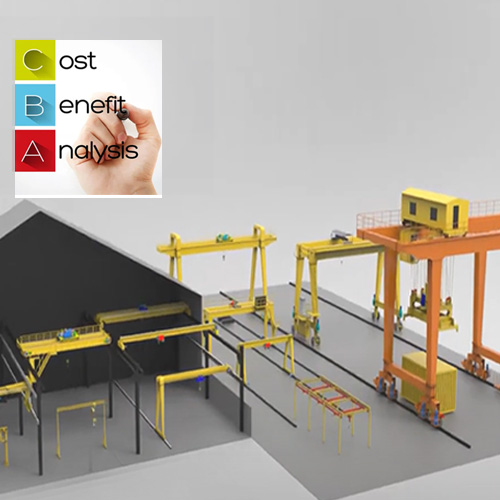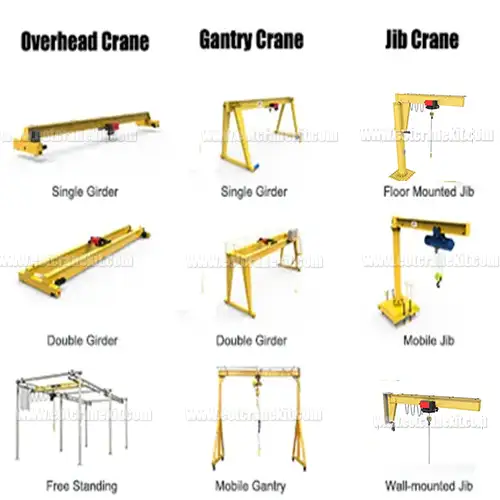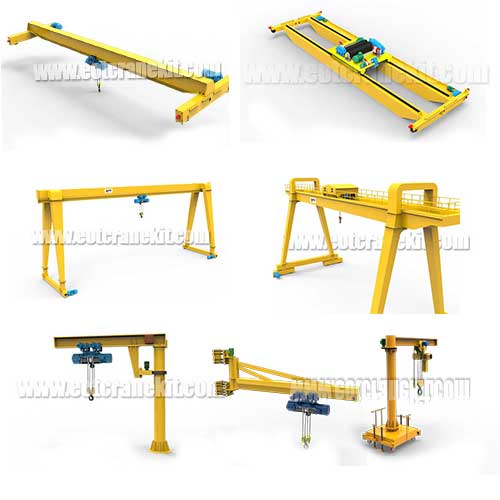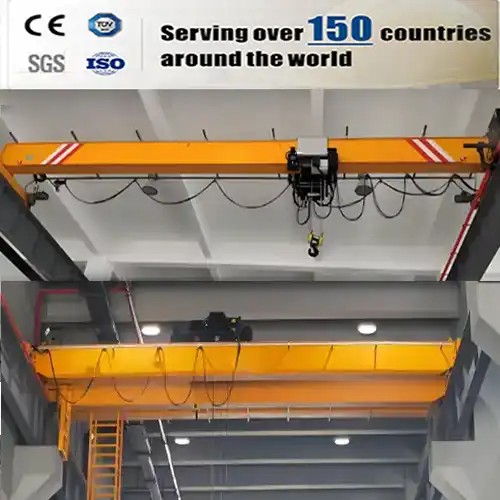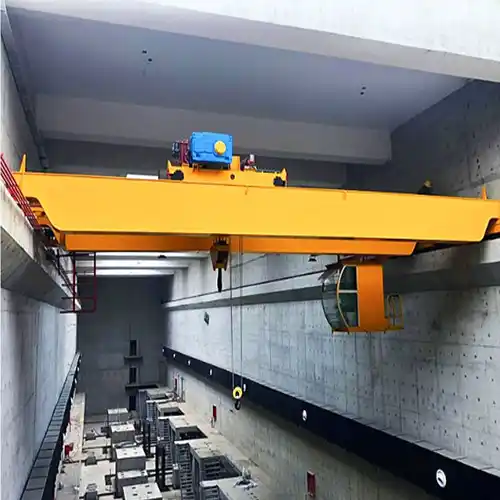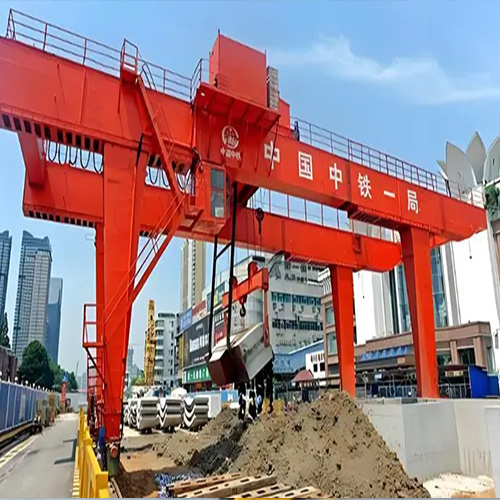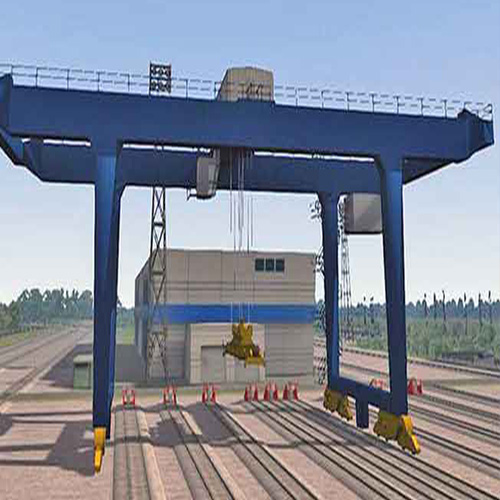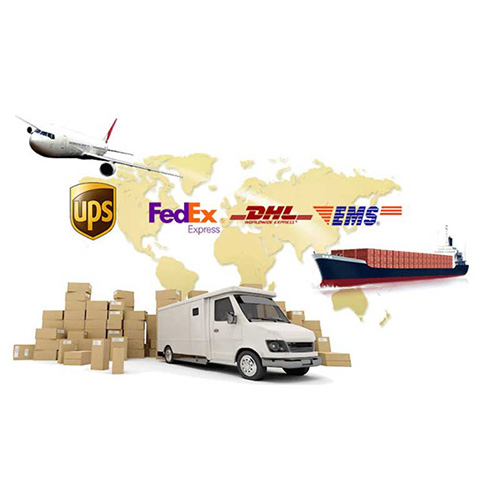Cost Analysis & Budgeting for Buying Overhead Cranes from China
What is cost of buying overhead crane from China? Analyze true cost of buying & operating overhead cranes from China & a budget that covers all expenses.
Category: China
Your Trusted Overhead Crane Manufacturer & Supplier in China
Cost Analysis & Budgeting for Buying Overhead Cranes from China
What is cost of buying overhead crane from China? Analyze true cost of buying & operating overhead cranes from China & a budget that covers all expenses.
Cost Analysis and Budgeting for Buying Overhead Cranes from China
Total Cost of Ownership
In the field of overhead cranes, the initial purchase price is just the tip of the iceberg. When you embark on the journey of acquiring overhead cranes from China, it's crucial to understand that the true cost goes beyond the price tag hanging from the crane. This holistic approach to cost assessment is known as Total Cost of Ownership (TCO), and it plays a pivotal role in making informed decisions and creating a budget that covers all expenses.
Why TCO Matters
TCO encompasses all costs associated with owning and operating overhead cranes throughout their entire lifecycle. While the upfront purchase price is a significant component, it's accompanied by various other expenses that can significantly impact your bottom line. By considering the TCO, you gain a more accurate and comprehensive understanding of what you'll pay for your cranes over time.
Beyond the Initial Purchase
The initial purchase price of an overhead crane is influenced by several factors, including its type, capacity, features, and customization. While it's an essential consideration, you can't stop at this point. Here's why:
- Operating and Maintenance Costs: Overhead cranes require ongoing maintenance and operational expenses. Regular servicing, inspections, and potential repairs all contribute to the crane's TCO.
- Transportation and Logistics: If you're importing cranes from China, you'll need to budget for transportation costs. Shipping, handling, and any customs-related expenses are part of this category.
- Import Duties and Taxes: Depending on your location and the applicable trade agreements, import duties and taxes may apply. These can significantly impact the overall cost of acquiring cranes.
- Documentation and Compliance: Obtaining permits, complying with regulations, and handling documentation all come with associated costs. Failure to budget for these can lead to delays and extra expenses.
- Insurance Costs: Ensuring the cranes during transit and operation is a prudent choice. Insurance premiums are part of the TCO equation.
- Customization Expenses: If you require customized features or specifications for your cranes, these come at an additional cost. Balancing customization with your budget is essential.
- Reserve and Contingency Funds: Unforeseen circumstances can lead to unexpected expenses. Having reserve and contingency funds in your budget can help you navigate such situations without derailing your project.
- ROI and Cost-Benefit Analysis: Assessing the Return on Investment (ROI) and conducting a cost-benefit analysis can help you determine whether the crane acquisition aligns with your long-term financial goals.
- Creating a Comprehensive Budget: To ensure you cover all these expenses, it's essential to create a comprehensive budget. This budget should be a dynamic tool that evolves as you gather information and make decisions.
In conclusion, understanding the Total Cost of Ownership is an integral part of responsible overhead crane procurement. By considering all these expenses, you can make well-informed decisions and create a budget that ensures you're fully prepared for the price you'll pay, both upfront and over time.
Types of Overhead Cranes Manufactured in China
Chinese manufacturers produce various types of overhead cranes, each designed for specific applications.
- Bridge cranes are one of the most common types of overhead cranes manufactured in China. They are used to lift and move heavy loads across a factory or warehouse. They consist of a bridge that runs along two parallel rails, with a hoist and trolley system that moves along the bridge.The overhead bridge cranes are mainly classified into single girder overhead crane 1 ton to 20 tons , double girder overhead cranes 3 ton to 320 ton , top running overhead cranes 3 ton to 550 ton , and underslung bridge cranes 1 ton to 10 tons.
- Gantry cranes are similar to bridge cranes but are supported by legs instead of rails. They are commonly used in outdoor applications, such as shipping yards or construction sites.
- Jib cranes are designed for lifting and moving loads in a circular area. They consist of a horizontal beam (jib) that is attached to a vertical mast, with a hoist and trolley system that moves along the jib.
- Monorail cranes are used for moving loads along a single path. They consist of a hoist and trolley system that moves along a single rail, which can be mounted on a ceiling or on a freestanding support structure.
Initial Purchase Price
When diving into the realm of acquiring overhead cranes from China, it's crucial to recognize that the initial purchase price forms the foundation of your budgeting efforts. However, this price is not set in stone and can fluctuate based on several key factors.
Factors Influencing the Initial Purchase Price
- Crane Type: The type of overhead crane you choose significantly impacts the initial cost. Single girder cranes, double girder cranes, gantry cranes, and jib cranes, to name a few, all come with different price points.
- Capacity: The lifting capacity of the crane plays a substantial role in determining its cost. Cranes designed for heavy industrial lifting will typically have a higher price tag compared to those intended for lighter loads.
- Customization: Tailoring the crane to your specific needs can lead to price variations. Custom features, specialized configurations, or unique requirements will incur additional expenses.
- Brand and Manufacturer: The reputation and brand of the manufacturer also influence pricing. Well-established manufacturers may charge a premium for their cranes due to their track record and quality.
- Quality and Features: Cranes with advanced features, modern technology, and higher build quality tend to come with a higher initial cost. These features can enhance crane performance and longevity.
- Supplier Negotiations: Your negotiation skills and the terms you agree upon with the supplier can impact the purchase price. Effective negotiation may lead to cost savings.
- Volume and Order Size: Larger orders or bulk purchases can sometimes result in volume discounts or more favorable pricing terms from the manufacturer.
Navigating Price Variations
Understanding the factors that influence the initial purchase price is essential for effective budgeting. Here's how you can navigate these price variations:
- Define Your Requirements: Start by clearly defining your overhead crane requirements. Knowing the crane type, capacity, and any necessary customizations will help you obtain accurate price quotes.
- Compare Quotes: Obtain quotes from multiple manufacturers and suppliers. This allows you to compare prices, features, and terms to find the best fit for your budget.
- Consider Long-Term Costs: While it's tempting to focus solely on the initial purchase price, remember that lower upfront costs may lead to higher maintenance and operational expenses over time. Consider the Total Cost of Ownership (TCO) for a more comprehensive view.
- Balance Quality and Cost: Striking the right balance between quality and cost is crucial. Opting for the lowest-priced crane may result in performance issues and increased maintenance down the line.
- Seek Expert Advice: If you're uncertain about which crane type or configuration is best for your needs, consult with experts or engineers who specialize in overhead cranes. Their insights can help you make informed decisions.
In summary, the initial purchase price of overhead cranes from China is influenced by various factors. Understanding these factors, comparing quotes, and considering long-term costs are essential steps in budgeting for your crane acquisition. Balancing quality and cost is key to a successful investment.
Operating and Maintenance Costs
While the initial purchase price of overhead cranes is a significant expense, it's only one part of the financial equation. To create an accurate budget, it's crucial to factor in the ongoing operating and maintenance costs associated with these essential pieces of equipment.
All types of overhead cranes for sale in China, the economical traditional types and European style overhead crane with adanvanced features and smart features
Analyzing Ongoing Operating Costs
- Energy Consumption: Overhead cranes require electricity to operate. The energy efficiency of the crane's design and usage patterns will impact your electricity bills. Consider the crane's power consumption when budgeting for operational expenses.
- Labor Costs: Operating overhead cranes involves labor. You'll need trained operators to ensure safe and efficient crane use. Factor in labor costs, including wages, benefits, and training, when budgeting.
- Downtime and Productivity Loss: Unexpected downtime due to breakdowns or maintenance can result in productivity loss. Consider the potential financial impact of downtime when budgeting.
Understanding Maintenance Costs
- Routine Maintenance: Overhead cranes, like any machinery, require regular maintenance to ensure they function correctly and safely. Routine inspections, lubrication, and minor repairs are essential to prevent larger issues. Budget for these recurring expenses.
- Repairs and Spare Parts: Despite proactive maintenance, breakdowns can occur. Budget for potential repair costs and the purchase of spare parts. Consider the availability and cost of spare parts from your crane supplier.
- Compliance and Inspections: Compliance with safety standards often requires periodic inspections and certifications. Budget for inspection fees and any necessary modifications to maintain compliance.
Discussing Cost-Saving Measures
- Preventive Maintenance: Investing in preventive maintenance can reduce the frequency and severity of breakdowns, ultimately saving you money in the long run.
- Operator Training: Well-trained crane operators are more likely to use equipment efficiently and safely, reducing the risk of accidents and costly downtime.
- Energy-Efficient Equipment: Consider energy-efficient overhead cranes and technologies that can lower your electricity bills over time.
- Spare Parts Inventory: Maintaining an inventory of critical spare parts can reduce downtime by ensuring quick access to replacements when needed.
Incorporating operating and maintenance costs into your budget ensures that you have a comprehensive view of the financial aspects of owning and operating overhead cranes. It's essential to strike a balance between initial purchase price and ongoing costs to make informed decisions about your crane investment.
Transportation and Logistics
When acquiring overhead cranes from China, one significant expense that should not be overlooked is transportation and logistics. Safely moving these large and heavy pieces of equipment from the manufacturing site to your location involves several cost considerations.
Detailing Transportation Costs
- Freight Charges: The cost of transporting overhead cranes from China to your destination can vary widely depending on the size and weight of the crane, the shipping method chosen (e.g., sea freight, air freight, or land transport), and the distance to be covered.
- Insurance: Insurance is crucial to protect your investment during transit. Budget for insurance coverage that provides adequate protection in case of damage or loss during shipping.
- Customs Fees: Customs fees, including import duties and taxes, may apply when the cranes arrive at your country's port. These fees can significantly impact your budget, so it's essential to understand the specific requirements and rates.
Logistics Considerations
- Shipping Routes: The choice of shipping routes can affect both cost and transit time. Longer routes may be more cost-effective but could result in longer delivery times.
- Packaging: Proper packaging of the cranes to ensure their safety during transit is an essential consideration. Budget for packaging materials and methods that meet industry standards.
- Customs Clearance: Clearing customs involves paperwork and, in some cases, customs broker fees. Factor in these costs when budgeting for logistics.
- Storage: If there are delays in transit or if your facility is not ready to receive the cranes immediately, you may need to budget for temporary storage.
Budgeting for Unexpected Costs
It's crucial to budget for unexpected costs that may arise during transportation and logistics. These could include additional customs inspections, port storage fees, or unexpected shipping delays. Having a contingency budget can help you navigate unforeseen expenses.
By accounting for transportation and logistics costs when budgeting for overhead cranes from China, you'll ensure that your financial plan is comprehensive and that you're prepared for the entire procurement process, from the factory to your facility.
Import Duties and Taxes
When procuring overhead cranes from China, one of the critical considerations in your budgeting process should be import duties and taxes. These additional costs can significantly impact the overall price you pay for the cranes.
Understanding Import Duties and Taxes
Import Duties: Import duties, also known as tariffs, are taxes levied on goods when they enter a foreign country. The rate of import duty can vary depending on the country of import and the type of crane being imported. Research the specific import duty rates applicable to overhead cranes in your country.
Value Added Tax (VAT): VAT is another type of tax that may apply to imported cranes. The rate of VAT varies between countries and can be a significant portion of the overall cost. Some regions may offer exemptions or reduced rates for certain industries or crane types.
Budgeting for Import Duties and Taxes
To budget effectively for import duties and taxes:
- Research and Calculation: Research the import duty and VAT rates applicable in your country for the type of crane you intend to import. You can often find this information on government websites or by consulting with customs authorities. Calculate the estimated amount of these taxes based on the crane's value.
- Consult with Experts: It's advisable to seek advice from experts, such as customs brokers or import/export consultants, who can provide guidance on the applicable taxes and any potential exemptions or reductions. They can help ensure that your budget accurately accounts for these costs.
- Plan for Contingencies: While you can make informed estimates, unforeseen circumstances or changes in tax regulations can affect your final tax liability. Include a contingency fund in your budget to accommodate any unexpected tax-related expenses.
- Leverage Trade Agreements: Some countries have trade agreements or preferential trade arrangements with China that can reduce or eliminate certain import duties and taxes. Investigate whether your country has any such agreements in place and take advantage of them when applicable.
By thoroughly researching and budgeting for import duties and taxes, you'll avoid any financial surprises during the procurement process. Proper budgeting ensures that you have the necessary funds to cover all aspects of acquiring overhead cranes from China while complying with your country's import regulations.
Documentation and Compliance Costs
When procuring overhead cranes from China, it's essential to consider the expenses associated with documentation and compliance. Meeting the necessary regulatory and paperwork requirements is crucial to ensuring a smooth and legally compliant acquisition process.
Understanding Documentation and Compliance Costs
- Permit and License Fees: Depending on your country's regulations and the type of crane you're importing, you may need to obtain permits or licenses. These often come with associated fees that need to be factored into your budget.
- Customs Documentation: Properly completing customs documentation is critical for clearing your cranes through customs. While some documentation may be handled by your freight forwarder or customs broker, there may still be fees for their services.
- Legal and Compliance Consulting: In some cases, businesses may opt to consult with legal experts or compliance professionals to ensure they meet all regulatory requirements. These services can add to your expenses but can be valuable in avoiding costly compliance issues.
- Budgeting for Documentation and Compliance Costs
To budget effectively for documentation and compliance costs:
- Research and Regulatory Understanding: Begin by thoroughly researching the specific documentation and compliance requirements for importing overhead cranes in your country. Understand the types of permits or licenses needed and any associated fees.
- Consult with Experts: If the regulatory landscape is complex or unfamiliar, consider consulting with experts who specialize in import compliance. They can provide guidance on the necessary steps and associated costs.
- Allocate a Compliance Budget: Create a dedicated budget category for compliance-related expenses. This ensures that you have the funds set aside specifically for permits, licenses, customs documentation, and any consulting fees.
- Regularly Update Documentation: Keep your documentation and compliance costs budget up-to-date. Regulatory requirements can change, so it's essential to stay informed and adjust your budget accordingly.
By carefully budgeting for documentation and compliance costs, you'll not only ensure a legally sound procurement process but also avoid potential delays and fines that can result from non-compliance. Proper planning in this area contributes to the overall success and cost-effectiveness of acquiring overhead cranes from China.
Insurance Costs
Insurance is a critical aspect of overhead crane procurement, covering potential risks during transportation, installation, and operation. Understanding insurance costs and options is essential for creating a comprehensive budget.
Insurance Costs
- Transportation Insurance: This type of insurance covers the crane while it's in transit from the manufacturer in China to your location. Costs vary based on factors like distance, mode of transport, and the crane's value.
- Operational Insurance: Once the crane is in use, you'll need insurance to protect against potential accidents or damage during operation. Operational insurance costs depend on crane type, location, and usage.
- Comprehensive Coverage: Some buyers opt for comprehensive insurance that covers both transportation and operational risks. While more expensive, this can simplify insurance management.
Budgeting for Insurance Costs
To budget effectively for insurance costs:
- Evaluate Risk: Assess the potential risks involved in transporting and operating the crane. The value of the crane, the distance it travels, and the operating environment all impact insurance needs.
- Request Quotes: Obtain insurance quotes from reputable providers, considering both transportation and operational coverage. Compare quotes to find the best balance between cost and coverage.
- Include in Your Budget: Allocate a specific portion of your budget to insurance costs. Keep in mind that insurance is not an area to cut corners; adequate coverage is crucial.
- Regular Review: Periodically review your insurance coverage to ensure it aligns with your crane's current value and usage. Adjust your budget accordingly if coverage needs change.
- Claims Management: Understand the claims process for your insurance provider. In case of damage or loss, prompt and accurate claims handling can minimize financial impacts.
Insurance costs are a necessary part of overhead crane ownership. While they add to the overall expenses, they provide invaluable protection against unforeseen events that could otherwise result in significant financial losses. By carefully budgeting for insurance, you can safeguard your investment and ensure the smooth operation of your crane.
Customization Expenses
Customization is a powerful tool for tailoring overhead cranes to your specific needs, but it comes with its own set of expenses that must be considered when budgeting for your acquisition.
Analyzing Customization Expenses
- Design and Engineering Costs: Customizing a crane often involves engineering and design work to meet unique specifications. This can include changes to the crane's structure, controls, or safety features.
- Materials and Components: Customized cranes may require specialized materials or components that differ from standard configurations. These materials can come at a higher cost.
- Manufacturing and Assembly: The process of manufacturing and assembling a customized crane can be more labor-intensive and time-consuming, potentially increasing production costs.
- Testing and Quality Assurance: Customized cranes may need additional testing and quality assurance measures to ensure they meet safety and performance standards.
Trade-Offs Between Customization and Cost
While customization allows you to get the precise crane you need, it's important to consider the trade-offs:
- Increased Cost: Customization almost always comes with added expenses. Buyers should be prepared for potentially higher upfront costs.
- Longer Lead Times: Customized cranes may take longer to design, manufacture, and deliver. Factor in longer lead times when planning your project.
- Expertise Matters: Working with experienced crane manufacturers is crucial when customizing. They can help you navigate the process efficiently and effectively.
- ROI and Fit-for-Purpose: Assess whether the added cost of customization delivers a return on investment (ROI) in terms of improved performance, efficiency, or safety for your specific application.
Budgeting for Customization
When budgeting for customization:
- Define Your Needs: Clearly define the customization requirements based on your project's demands. Consult with crane experts to determine what modifications are necessary.
- Get Quotes: Obtain detailed quotes from crane manufacturers for the customization work. Ensure quotes cover all aspects of customization, including design, materials, and labor.
- Consider Long-Term Benefits: Evaluate how customization impacts your crane's long-term performance and maintenance costs. Sometimes, a higher upfront investment can lead to lower operating costs.
- Allocate Funds: Allocate a specific portion of your budget for customization expenses, ensuring it doesn't compromise other essential aspects of your project.
- Regular Communication: Maintain open communication with the manufacturer throughout the customization process to address any changes or issues promptly.
Customization can significantly enhance the suitability of your overhead crane for its intended purpose. While it adds to the budget, careful planning and consideration of the long-term benefits can justify the investment. Balancing customization with cost-effectiveness is the key to a successful crane acquisition.
Reserve and Contingency Funds
In the world of overhead crane acquisition, unforeseen expenses can sometimes emerge, and having reserve and contingency funds is a wise financial strategy to ensure a smooth procurement process.
Advising on the Importance of Reserve and Contingency Funds
- Unforeseen Circumstances: No matter how meticulous your budgeting process, unexpected situations can arise during the acquisition of overhead cranes. These might include sudden changes in shipping costs, delays in customs clearance, or unforeseen modifications required for compliance.
- Risk Mitigation: Reserve and contingency funds act as a financial safety net. They provide you with the flexibility to address unexpected costs without jeopardizing the progress of your crane acquisition project.
- Budget Protection: Allocating a portion of your budget to reserves ensures that your core funds remain intact. This safeguards your ability to complete the purchase while accommodating unforeseen financial demands.
- Reducing Stress: Knowing you have reserve and contingency funds in place can provide peace of mind during the procurement process. It allows you to focus on the project's success rather than worrying about unexpected financial setbacks.
Recommendations for Determining the Appropriate Reserve Amount
- Assess Potential Risks: Start by assessing potential risks and uncertainties associated with your overhead crane acquisition. Consider factors like shipping, customs, currency fluctuations, and regulatory compliance.
- Consult with Experts: Seek advice from professionals in crane acquisition or international procurement who can provide insights into common unexpected expenses.
- Allocate a Percentage: Allocate a percentage of your total budget as reserves and contingency funds. While there is no one-size-fits-all rule, setting aside 10-15% of your budget is a common practice.
- Continuous Monitoring: Continuously monitor your project's progress and expenses. If unforeseen costs arise, tap into your reserve funds as needed.
- Use Funds Wisely: Utilize your reserve and contingency funds judiciously. They are meant for genuine unforeseen expenses, not as a buffer for overspending.
- Regular Updates: Keep stakeholders informed about the existence and purpose of these funds. Transparency ensures that everyone understands the financial safeguards in place.
By allocating reserve and contingency funds, you are taking a proactive approach to financial management during the overhead crane acquisition process. This not only enhances your ability to address unforeseen challenges but also demonstrates prudent financial planning to stakeholders and partners involved in the project.
ROI and Cost-Benefit Analysis
Understanding the Return on Investment (ROI) and conducting a cost-benefit analysis are pivotal steps in the process of acquiring overhead cranes from China. These analyses help you make informed decisions and assess the long-term financial impact of your crane investment.
Discussing How to Calculate Return on Investment (ROI)
- ROI Fundamentals: ROI is a financial metric that measures the profitability of an investment relative to its cost. It is calculated as the net gain or loss from the investment divided by the initial cost.
- Gather Financial Data: Start by gathering all relevant financial data, including the total cost of acquiring the overhead crane, ongoing operational expenses, and expected revenues or cost savings generated by the crane.
- Calculate Net Gain: Calculate the net gain from the crane investment by subtracting the total cost and ongoing expenses from the expected revenues or cost savings over a specified period.
- ROI Formula: Use the following formula to calculate ROI: [ ROI = \frac{Net Gain from Investment}{Total Cost of Investment} \times 100 \]
- Interpretation: A positive ROI indicates that your crane investment is profitable, while a negative ROI suggests a financial loss. The percentage value quantifies the return relative to the initial investment.
- Consider Timeframe: Be mindful of the timeframe over which you calculate ROI. Short-term and long-term ROI assessments may yield different results.
Conducting a Cost-Benefit Analysis
- Identify Costs and Benefits: Begin by identifying all relevant costs associated with the overhead crane acquisition, including the initial purchase price, operating costs, transportation expenses, and customs duties. Simultaneously, list the expected benefits, such as increased productivity, reduced labor costs, or improved safety.
- Quantify Costs and Benefits: Assign specific monetary values to each cost and benefit. This step may involve estimating potential savings or increased revenue resulting from crane usage.
- Calculate Net Benefit: Calculate the net benefit by subtracting the total costs from the total benefits. A positive net benefit indicates that the crane acquisition generates more value than it costs.
- Consider Risk and Uncertainty: Acknowledge potential risks and uncertainties that can affect both costs and benefits. Consider conducting sensitivity analyses to account for different scenarios.
- Present the Findings: Present the results of your cost-benefit analysis in a clear and concise manner, highlighting the financial viability of the crane acquisition. This information is valuable for decision-makers and stakeholders.
- Long-Term Perspective: Keep in mind that the benefits of overhead cranes often extend beyond the immediate financial gains. Factors like increased efficiency and improved safety may have long-term positive effects on your operations.
By calculating ROI and conducting a thorough cost-benefit analysis, you gain valuable insights into the financial implications of acquiring and operating overhead cranes. These analyses empower you to make data-driven decisions, align your investment with your organization's goals, and assess the true value of your crane procurement.
Creating a Comprehensive Budget
After delving into the diverse cost components and considerations associated with acquiring overhead cranes from China, it's time to bring everything together and create a comprehensive budget. A well-structured budget not only helps you manage your finances effectively but also ensures that you have a clear overview of all expenses related to your crane procurement.
Summarizing the Various Cost Components
- Initial Purchase Price: The upfront cost of acquiring the overhead crane, influenced by crane type, capacity, and customization.
- Operating and Maintenance Costs: Ongoing expenses for crane operation, including electricity, servicing, and replacement parts.
- Transportation and Logistics: Costs related to shipping cranes from China to your location, including freight charges, handling, and import duties.
- Documentation and Compliance Costs: Expenses for obtaining necessary permits and complying with import regulations.
- Insurance Costs: Premiums for insuring cranes during transportation and operation.
- Customization Expenses: Costs associated with tailoring cranes to your specific requirements.
- Reserve and Contingency Funds: Funds set aside to address unforeseen expenses and emergencies.
Creating a Comprehensive Budget - Step by Step
- List All Cost Components: Begin by listing all the cost components mentioned above. Ensure that you have accounted for every relevant expense.
- Assign Monetary Values: Assign specific monetary values to each cost component. This step involves gathering quotes, estimates, and financial data to quantify expenses accurately.
- Consider Timeframes: Determine the timeframe for your budget. Will it cover only the acquisition phase, or will it extend into the operational phase of the crane's lifespan?
- Calculate Total Costs: Sum up all the monetary values assigned to the cost components to calculate the total cost of your crane procurement.
- Include Reserves: Allocate a portion of your budget to reserve and contingency funds. The amount can be a percentage of the total cost or a fixed sum, depending on your risk assessment.
- Monitor and Update: Regularly monitor your budget as you progress through the procurement process. Update it as new information becomes available or if there are changes in project scope.
- Communicate and Review: Share the budget with relevant stakeholders, such as financial decision-makers and project managers. Ensure everyone understands and agrees with the financial plan.
- Plan for ROI: Consider how the expenses in your budget align with the expected return on investment (ROI) and the financial benefits your crane acquisition will bring.
- Adapt and Revise: Be prepared to adapt and revise your budget as circumstances evolve. Flexibility is key to successful budget management.
If you have any need of hoist or crane, please feel free to contact us to learn more.
Main Projects
Related Products

Supplied three grab bucket crane kits to Indonesia, enhancing garbage handling efficiency with high load capacity and reliable performance.
Free consultation to Confirm Parameters & Specifications and Get
Latest Crane Price & Crane Rate.
- Types of overhead cranes : _______?
- Optional: Overhead travelling crane, goliath gantry crane,Slewing jib crane, Single girder or double girder crane,small portable crane or kbk crane, etc.
- Capacity of overhead crane: _______?
- Optional: 0.25ton, 0.5 ton, 1 ton, 2 ton, 3ton, 5 ton, 10 ton,15ton, 20ton, 25 ton, 30ton,35ton, up to 550ton, etc.
- Crane span & lifting height : _______?
- Crane travelling length : _____?
- Control of overhead crane:_______?
- Optional: pendant/ remote/cabin control
- Voltage supply of overhead crane:_____?
- Eg,: 380V50/60HZ,3Phase or others,etc.
- Application/usage of crane:_______?
- Eg,: Steel mill, ,injection mold, cement,stone, concrete,granite, general manufacturing, etc.
Just leave a message via the contact form and our hoist and crane engineer will contact you with in 24working hours.
Get In Touch
